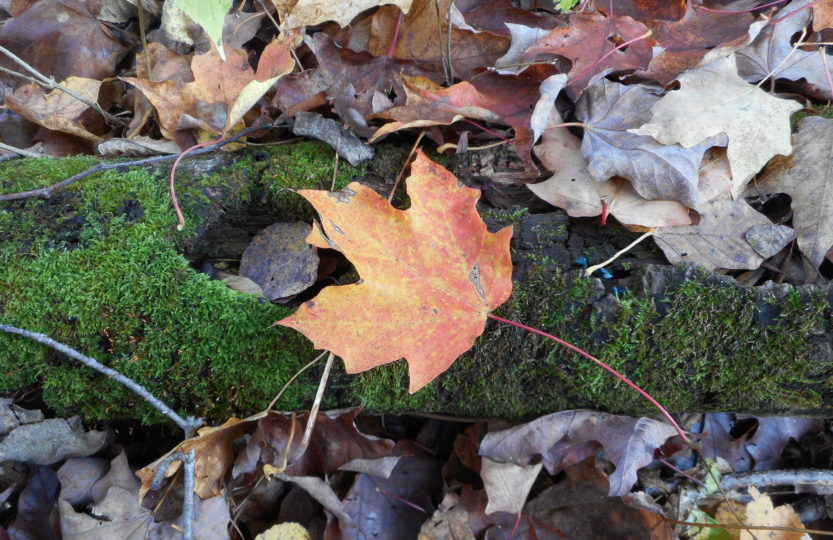The above picture was taken during Binaakwe-giizis (Falling Leaves Moon) next to an old aninaatig (maple tree) where my son and I spend a lot of time year round. It has become a special place for us to return throughout the cycles of the year.
As a lover of science and nature, I’m a fan of phenology. My most recent post, Fun with Phenology as a Family, highlighted fun ways to connect more to the cyclical changes in the natural world. During my writings on phenology, I was drawn to thinking about the ways Ojibwe traditional activities follow these cyclical changes. The names of the giizisoog (moons) focus on what is done during certain times of the year according to what is happening in nature. Although the following list names 12 months and lists Ojibwe moon names that correlate, know that there are actually 13 giizisoog each gikinoonowin (year) following the moon cycles. It’s also important to be aware of the influence of colonization on the Ojibwe language. You can see this influence reflected in the name for Manidoo-giizisoons (Little Spirit Moon). This name has been influenced by the Christian holiday of Christmas. Following are the names that I was taught for the giizisoog. Knowing the reasons these moons are named a certain way is just as important as knowing their name. I won’t get into all the reasons for the names in this post, but I aim to in future ones. These giizisoog vary according to the specific region you are from, since the cyclical changes in nature happen at different times in different areas. Teachings also vary, so it is important to ask an elder or other knowledgeable person about the names used in the specific area you are from.
Giizisoog (The Moons)
January
Gichi-manidoo-giizis (Great Spirit Moon), Aabitaa-biboonigiizis (Halfway Winter Moon)
February
Namebini-giizis, (Suckerfish Moon), Migiziwi-giizis (Bald Eagle Moon), Webinigewi-giizis (Throwing Away Moon), Gaa-takoozid giizis (The Short Moon)
March
Aandego-giizis (Crow Moon), Onaabini-giizis (Hard Crust on the Snow Moon), Makoonsag-gaa-nitaawigiwaatiwi-giizis (Birth of Bear Cubs Moon)
April
Iskigamizige-giizis (Sap-boiling Moon)
May
Waabigwani-giizis (Flower Moon), Zaagibagaa-giizis (Budding Moon)
June
Ode’imini-giizis (Strawberry Moon)
July
Aabita-niibino-giizis (Halfway Summer Moon), Miinike-giizis (Blueberry Moon)
August
Manoominike-giizis (Ricing Moon)
September
Waatebagaa-giizis (Leaves Turning Color Moon), Manoominike-giizis (Ricing Moon)
October
Binaakwe-giizis (Raking Leaves or Falling Leaves Moon)
November
Gashkadino-giizis (Freezing Over Moon)
December
Manidoo-giizisoons (Little Spirit Moon)
Indian Country Today summarizes really nice thoughts surrounding the subject of phenology and Native American tradition. They say, “It’s likely that there is no Native word for phenology, the study of cyclical changes in the natural world. Yet phenology was part of the fabric of Native tradition that kept the generations alive, and that ancient, evolving tradition appears in the many Native American moon names.” People in tribal communities are seeking to better understand the changes seen in these cycles resulting from climate change. The Great Lakes Indian Fish and Wildlife Commission has launched a phenology study, which is now in its second year, hoping to better understand these cyclical changes. I love the beautiful way this study was introduced to the forest through ceremony. You can read about this ceremony which showed respect and asked permission to the forest in the Winter 2015-2016 Mazina’igan.
Right now in my area, it is Onaabini-giizis. That is when there is a hard crust on the snow. When you walk across the snow, you can feel the hard crust on the top caused by the warming and cooling temperatures. It is also when the crows arrive on their migration back to the northern parts of Minnesota. During Aandego-giizis, we have had an abundance of aandegwag (crows) returning to areas farther north. I’m still waiting to see the first fog of the year which tells of the bear cubs born during this moon, Makoonsag-gaa-nitaawigiwaatiwi-giizis. As we approach the end of the month and the new moon, Iskigamizige-giizis, the warming weather will have the trees running with sap marking the traditional time for sugar camp. Every year, I seek to learn a little more about the Ojibwe traditional activity of making maple syrup. Following is a list of some great resources to learn about the process along with some links to Ojibwe words for when you’re at an iskigamizigan (sugar camp).
Iskigamizige-giizis Resources
- Porky’s Sugar Bush is a wonderful video that tells how maple syrup came to the Ojibwe and summarizes the hard work that goes into working together at sugar camp.
- A lot of people, now, use collection bags for sap as you saw in the video from Porky’s Sugar Bush. Check out this great video on how to make a biskitenaagan which is a folded birch bark basket used for catching sap. Here is a picture of a finished biskitenaagan.
- Native Art in Canada has great information on making maple syrup the traditional Ojibwe way when rocks were heated and placed in birch bark sap baskets.
- The Ojibwe People’s Dictionary has great historical pictures in their cultural gallery for Iskigamizigewin (sugaring). They also have a great list of words with audio that are helpful to know around the iskigamizigan (sugar camp). You can find these ikidowinan (words) here.
- The Mazina’igan Supplement is a great resource to share with the children in your life.
If you get the opportunity to head to a sugar bush, traditional or otherwise, I hope you find these resources helpful to learning more about Ojibwe language and culture and some fun topics to explore during this upcoming moon. Please do share in with your comments, experience, resources, or other knowledge. Nature Art Exploration loves hearing from you. Miigwech! (Thank you!)


